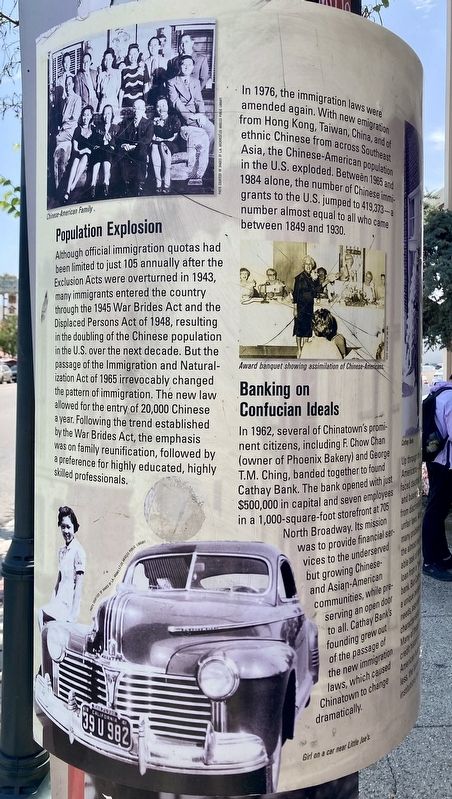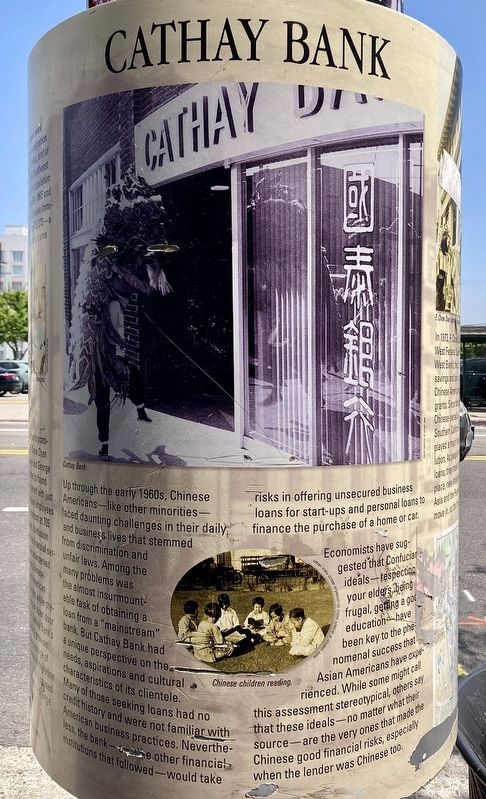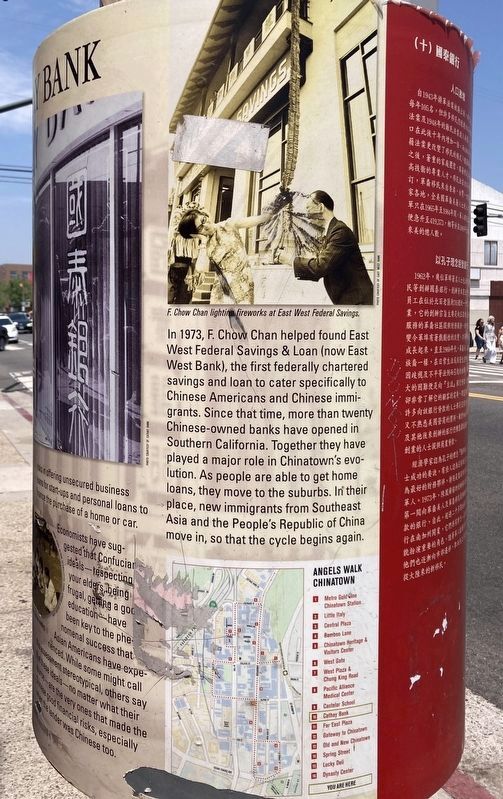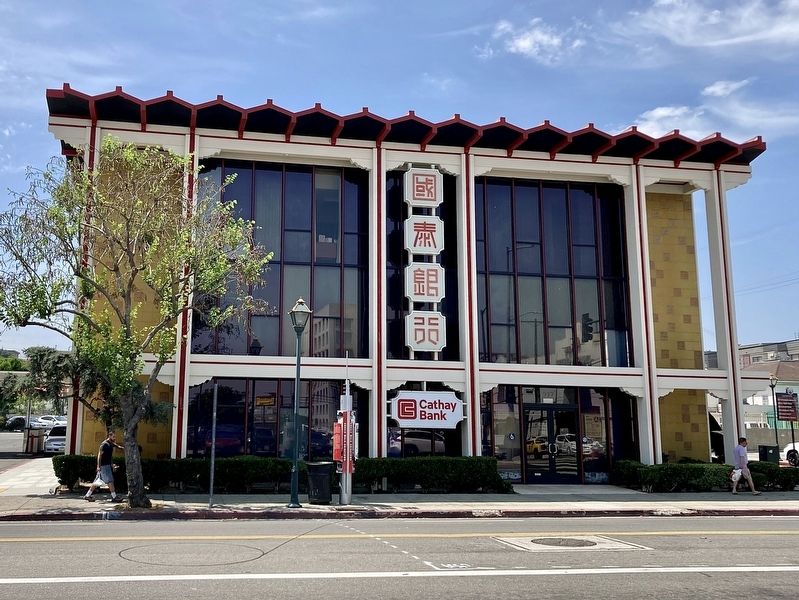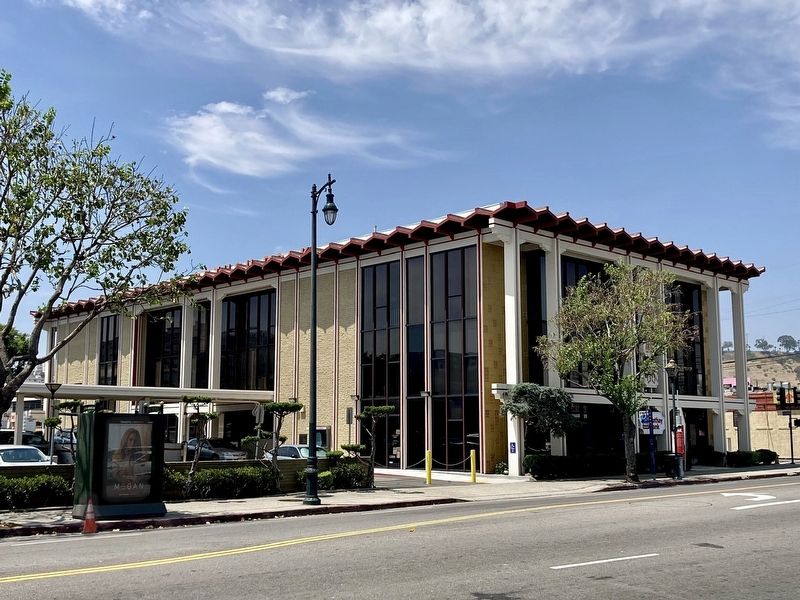Chinatown in Los Angeles in Los Angeles County, California — The American West (Pacific Coastal)
Cathay Bank
Population Explosion
Although official immigration quotas had been limited to just 105 annually after the Exclusion Acts were overturned in 1943, many immigrants entered the country through the 1945 War Brides Act and the Displaced Persons Act of 1948, resulting in the doubling of the Chinese population in the U.S. over the next decade. But the passage of the Immigration and Naturalization Act of 1965 irrevocably changed the pattern of immigration. The new law allowed for the entry of 20,000 Chinese a year. Following the trend established by the War Brides Act, the emphasis was on family reunification, followed by a preference for highly educated, highly skilled professionals.
In 1976, the immigration laws were amended again. With new emigration from Hong Kong, Taiwan, China, and of ethnic Chinese from across Southeast Asia, the Chinese-American population in the U.S. exploded. Between 1965 and 1984 alone, the number of Chinese immi grants to the U.S. jumped to 419,373 - a number almost equal to all who came between 1849 and 1930.
Banking on Confucian Ideals
In 1962, several of Chinatown's prominent citizens, including F. Chow Chan (owner of Phoenix Bakery) and George T.M. Ching, banded together to found Cathay Bank. The bank opened with just An $500,000 in capital and seven employees in a 1,000-square-foot storefront at 705 North Broadway. Its mission was to provide financial ser vices to the underserved but growing Chinese- and Asian-American communities, while pr Twitte serving an open dor to all. Cathay Bank's founding grew out of the passage of the new immigration laws, which caused Chinatown to change dramatically.
Up through the early 1960s, Chinese Americans - like other minorities - faced daunting challenges in their daily and business lives that stemmed from discrimination and unfair laws. Among the many problems was the almost insurmountable task of obtaining a loan from a "mainstream" bank. But Cathay Bank had a unique perspective on the needs, aspirations and cultural characteristics of its clientele. Many of those seeking loans had no credit history and were not familiar with American business practices. Nevertheless, the bank - and the other financial institutions that followed - would take risks in offering unsecured business loans for start-ups and personal loans to finance the purchase of a home or car.
Economists have suggested that Confucian ideals - respecting your elders, being frugal, getting a good education - have been key to the phenomenal success that Asian Americans have experienced. While some might consider this assessment stereotypical, others say that these ideals - no matter what their source - are the very ones that made the Chinese good financial risks, especially when the lender was Chinese too.
In 1973, F. Chow Chan helped found East West Federal Savings & Loan (now East West Bank), the first federally chartered savings and loan to cater specifically to Chinese Americans and Chinese immigrants. Since that time, more than twenty Chinese-owned banks have opened in Southern California. Together they have played a major role in Chinatown's evolution. As people are able to get home loans, they move to the suburbs. In their place, new immigrants from Southeast Asia and the People's Republic of China move in, so that the cycle begins again.
Erected 2003 by City of Los Angeles.
Topics. This historical marker is listed in these topic lists: Architecture • Asian Americans • Industry & Commerce. A significant historical year for this entry is 1943.
Location. 34° 3.742′ N, 118° 14.34′ W. Marker is in Los Angeles, California, in Los Angeles County. It is in Chinatown. Marker is at the intersection of Broadway and Alpine Street, on the right when traveling south on Broadway. Touch for map. Marker is at or near this postal address: 777 N Broadway, Los Angeles CA 90012, United States of America. Touch for directions.
Other nearby markers. At least 8 other markers are within walking distance of this marker. Far East Plaza (about 400 feet away, measured in a direct line); Lucky Deli (about 600 feet away); Castelar School (about 700 feet away); Pacific Alliance Medical Center (approx. 0.2 miles away); Sun Mun Way (approx. 0.2 miles away); Spring Street Chinatown (approx. 0.2 miles away); Historic Brick Pavers (approx. 0.2 miles away); Bruce Lee Statue (approx. 0.2 miles away). Touch for a list and map of all markers in Los Angeles.
Also see . . . Angels Walk L.A. Self-guided walking tours of historic neighborhoods in Los Angeles. The Cathay Bank marker is part of the Chinatown walk. (Submitted on July 25, 2023.)
Credits. This page was last revised on July 25, 2023. It was originally submitted on July 25, 2023, by Craig Baker of Sylmar, California. This page has been viewed 92 times since then and 31 times this year. Photos: 1, 2, 3, 4, 5. submitted on July 25, 2023, by Craig Baker of Sylmar, California.
